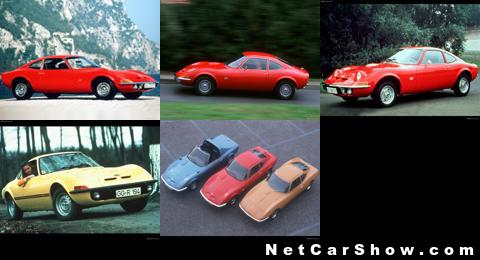Opel GT
"Only Flying is More Exciting" - this slogan has become a classic in advertising history, and even an everyday saying in German-speaking countries. It belonged to a car which has itself long since become a classic - the Opel GT. Its career got off to a flying start in 1965 when, to everyone's surprise, Opel presented an aerodynamic "Experimental Concept" at the IAA in Frankfurt - a car which did not fit into the usual world of central European high volume automobile production. In view of the sensational design, it was no surprise to see the production version on the road three years later. But what few people knew was that Opel had set a precedent: for the first time in Europe, a vehicle went into production that had initially debuted as a concept car.
The 1968 Opel Coupé could not deny a certain similarity to the legendary 1968 American Corvette, nor did it want to. It followed a new design style called the "Coke Bottle Shape", which also outstanding the Stingray. "Besides having a fantastic look, the Opel sports car was primarily designed to impress with sophisticated aerodynamics," explains Erhard Schnell, GT designer at the time. A sleek front end with retractable headlamps that rotate on the longitudinal axis, broad fender, tapered flanks in the door area, then bulky rear fenders which flow into the rear with sharp separating edges and round lamps - these were the Opel GT's key design characteristics.
"Safety belts are standard, please buckle up" - this was the Opel advertisement that promised GT occupants outstanding acceleration. And the driving performance the sporty 90 hp two-seater offered was truly top class in the late 1960s. Its 1.9-liter engine accelerated the GT from zero to 100 km/h in 10.8 seconds, and on to a top speed of 185 km/h. Almost 40 years ago, this was really fast. As a top model in the upper mid-class segment at that time, the Opel Rekord 1.9 had a top speed of 160 km/h, for example. The 200 km/h threshold was like the sound barrier, and had just been crossed by the muscle cars of that generation, such as the Mercedes 280 SE 3.5 with a 200 hp V8 engine. A Porsche 912 - which was commonly considered to be a car in the shape of the first 911, with four cylinders and 90hp, just like the Opel GT - also had a top speed of 185 km/h, but took 12.5 seconds from zero to 100 km/h.
The 1968 GT's sporty handling matched its performance figures thanks to a chassis with front twin A-arm axle and rear center-joint rigid axle with bolted springs, longitudinal control arm and lateral track bar.
Did you know that...?
- from 1968 to 1973, exactly 103,464 units of the GT were produced? The GT is a permanent collectors highlight, and a well-maintained model can fetch a fortune.
- 85 percent of the entire GT production run was exported, and 70,222 units (around 70 percent) went to the USA alone?
- the GT's body in white was created by French specialists Chausson (Reims), while Brisonneau & Lotz in Creil, north of Paris, took care of lacquering, electrics and interior equipment? The final car assembly took place in Bochum, where the body was 'married' to the powertrain and chassis. It was also the production center for the Kadett, upon which the GT was based.
- space for the 1.9-liter engine, which was also used in the Rekord, was so small that the hood had to be power domed and the cylinder-head cover skewed in the front section? The "Power dome" was not just for show!
- the Aero GT concept with removable targa roof was presented in 1969 at the IAA? One of the two prototypes can be found today in Opel's classic collection.
- the company founder's grandson, Georg von Opel, reached 188 km/h in mid-1971 at Hockenheim in a converted Opel GT with electric propulsion? The following year, a team of motoring journalists and race car drivers set 20 world records at the Opel Test Center in Dudenhofen in the "Diesel World Record GT 1972".
- many reasons led to the end of production in August 1973? These included demands from the USA - the most important export market - to fit bulky safety bumpers, which did not match the style of the car, and the fact that Brisonneau & Lotz was bought by Renault, signaling the end of the contractual relationship with Opel.
- Robert A. Lutz, "car guy", GM Vice Chairman, Global Product Development, was a sort of godfather to both Opel GTs? In 1968, in his position as Manager at Opel, he played a decisive role in speeding up the decision on series production, and he also gave the green light to the new General Motors roadster troop - Solstice, Sky and GT.
























